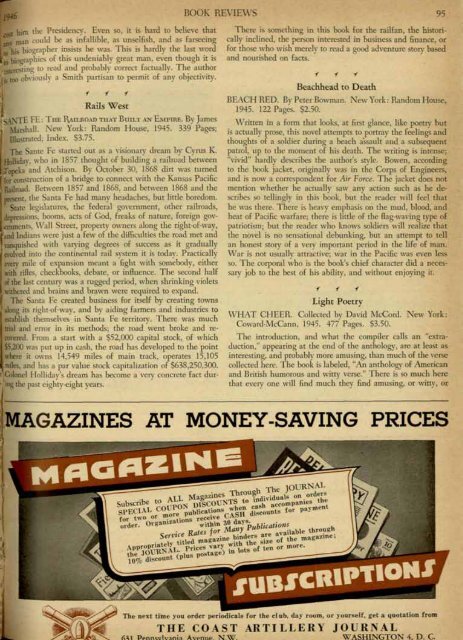January-February - Air Defense Artillery
January-February - Air Defense Artillery
January-February - Air Defense Artillery
Create successful ePaper yourself
Turn your PDF publications into a flip-book with our unique Google optimized e-Paper software.
BOOK REnEWS<br />
him the Presidency. E\'en so, it is hard to belieye that<br />
man could be as infallible, as unselfish, and as farseeing<br />
his biographer insists he was. This is hardly the last ,,"ord<br />
bios!raphies of this undeniably great man, eyen though it is<br />
:nc~ing to read an~ proba?ly correct f~ctually. Th~ a~t~or<br />
too ob\'iously a SmIth partIsan to permIt of any obJectmty.<br />
f<br />
f<br />
Rails \Vest<br />
S/l.l\"TEFE: THE !\AILROADTHATBUILT ANEMPIRE. By James<br />
Marshall. New York: Random House, 1945. 339 Pages;<br />
JIlustrated; Index. $3.75.<br />
The Sante Fe started out as a visionary dream by Cyrus K.<br />
oJlidav, who in 1857 thought of building a railroad between<br />
opeb' and Atchison. By October 30, 1868 dirt was turned<br />
construction of a bridge to connect with the Kansas Pacific<br />
Railroad. Between 1857 and 1868, and between 1868 and the<br />
~nt. the Santa Fe had many headaches, but little boredom.<br />
State legislatures, the feder~l government, other railroads,<br />
depressions, booms, acts of God, freaks of nature, foreign govments,<br />
\Vall Street, property owners along the right-of-way,<br />
and Indians were just a few of the diffIculties the road met and<br />
anguished with varying degrees of success as it gradually<br />
erolred into the continental rail system it is today. Practically<br />
every mile of expansion meant a fight with somebody, either<br />
with riRes, checkbooks, debate, or influence. The second half<br />
F the last century was a rugged period, when shrinking violets<br />
withered and brains and brawn were required to expand.<br />
The Santa Fe created business for itself by creating towns<br />
long its right-of-way, and by aiding farmers and industries to<br />
~ablish themselves in Santa Fe territory. There was much<br />
tial and error in its methods; the road went broke and re-<br />
\cred. From a start with a $52,000 capital stock, of which<br />
$5,200 was put up in cash, the road has developed to the point<br />
here it owns 14,549 miles of main track, operates 15,105<br />
iles, and has a par value stock capitalization of $638,250,300.<br />
Colonel Holliday's dream has become a very concrete fact dur-<br />
. 8Ig the past eighty-eight years.<br />
f<br />
f<br />
Beachhead to Death<br />
f<br />
f<br />
BEACH RED. By Peter Bowman. New York: Random House,<br />
1945. 122 Pages. $2.50.<br />
f<br />
f<br />
f<br />
95<br />
There is something in this book for the railfan, the historically<br />
inclined, the person interested in business and finance, or<br />
for those who wish merely to read a good ad\'enture story based<br />
and nourished on facts.<br />
\Vritten in a form that looks, at first glance, like poetry but<br />
is actually prose, this no\'e! attempts to portray the feelings and<br />
thoughts of a soldier during a beach a'ssault and a subsequent<br />
patrol, up to the moment of his death. The writing is intense;<br />
"vivid" hardly describes the author's style. Bowen, according<br />
to the book jacket, originally was in the Corps of Engineers,<br />
and is now a correspondent for <strong>Air</strong> Force. The jacket docs not<br />
mention whether he actually saw any action such as he describes<br />
so tellingly in this book. but the reader will feel that<br />
he was there. There is heavy emphasis on the mud, blood, and<br />
heat of Pacific warfare; there is little of the flag.waving type of<br />
patriotism; but the reader who knows soldiers will realize that<br />
the novel is no sensational debunking, but an attempt to tell<br />
an honest story of a very important period in the life of man.<br />
\Var is not usually attractive; war in the Pacific was even less<br />
so. The corporal who is the book's chief character did a necessary<br />
job to the best of his ability, and without enjoying it.<br />
Light Poetry<br />
WHAT CHEER. Collected by David McCord. New York:<br />
Coward-l\kCann, 1945. 477 Pages. $3.50.<br />
The introduction, and what the compiler calls an "extraduction,"<br />
appearing at the end of the anthology, are at least as<br />
interesting, and probably more amusing, than much of the verse<br />
collected here. The book is labeled, "An anthology of American<br />
and British humorous and witty verse." There is so much here<br />
that everyone will find much they find amusing, or witty, or<br />
MAGAZINES AT MONEY-SAVING PRICES<br />
The next time you order periodicals for the cI ub. da)' room, or )'ourself, get a quotation from<br />
THE COAST ARTILLERY JOURNAL<br />
(;~1 Ppnmvlv"n;" Avpnup. N.\.V. WASHIN'GTON 4. D. C.
















